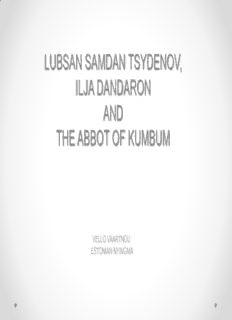
lubsan samdan tsydenov, ilja dandaron and the abbot of kumbum PDF
Preview lubsan samdan tsydenov, ilja dandaron and the abbot of kumbum
LUBSAN SAMDAN TSYDENOV, ILJA DANDARON AND THE ABBOT OF KUMBUM VELLO VAARTNOU ESTONIAN NYINGMA BURYTIA The Republic of Buryat, though being small in numbers, has given to the world many well-known intellectuals, scientists, cultural activist and Buddhists, who have become famous for their ideas and exploits. For example, explorer Gonbozav Tsybikov who made the first photos of Lhasa and brought them to Europe, the well-known doctor and peddler of Tibetan medicine Pjotr Badmayev; Agvan Dorjiev, famous teacher of the 13th Dalai Lama; Hambo lama Itegilov, today known as The Living Dead Buddhist Monk:\; philosopher and Hambo lama Choinzon Iroltuev; legendary ascetic Jangchub Tsultim (also Namnane lama), whose foremost students – Agvan Dorjiev and Samadan Tsydenov – shaped the Buddhism of Russia in the 19-20th century; To these distinguished names we must add Dorjiev` Kalmyk student Geshe Wangyal who brought the linage of Namnane Lama also to America in the 1950's through his students Jeffrey Hopkins and others. . HAMBO LAMA IROLTUEV HAMBO LAMA ITIGELOV AGVAN DORJIEV LUBSAN SAMDAN TSYDENOV BUDDHISM IN BURYATIA • Late 17th to the end of 19th century - spread of Buddhism • End of 19th to early 20th century - ‘golden age’ of Buddhism • 1920s to late 1980s - destruction and persecution of Buddhism • Late 1980s to present- restoration of the Sangha First Buddhist contact was made prior to Buryat joining the Russian Empire. In the early 17th century, Tibetan Buddhism spread north from Mongolia to Buryat communities of the Baikal region. In 1712, a group of 150 Mongolian and Tibetan monks fled Mongolia arrived in Buryatia and converted most of the population in the eastern part of the province to Buddhism.At that time prayer yurts of nobles and public nomadic temples began to appear. In 1727, Buryats became loyal to the Russian Empire, since the “Russian-Chinese agreement on the borders” was signed in Kyakhta. In 1741, Empress Elizabeth issued a decree that recognized the Lamaistic belief in Buryatia, authorized establishing of 11 monasteries (datsans) with 150 lamas on the staff and decreed these monks exempt from taxation and other obligations. Selenga Buryats of that time did not consider themselves separate from the Buddhist centers of Mongolia and in fact belonged to the Mongolian Sangha. . TSUGOLSKI DATSAN, THE FIRST WOODEN TEMPLE BUILDING MONASTERIES AND PUBLISHING BUDDHIST LITERATURE In 1753, Tsugolski datsan, the first wooden temple, was established at the initiative of Damba Darzha Zayaev, a young Mongolian nobleman who had studied inTibet. At the same time, the Gusinoozersky Datsan was built at the initiative of Zhimba Akhaldaev, who had studied in Urga, Mongolia. A third centre emerged among the Khori Buryats All three centers competed for leading positions. Officially all Buddhists of the Transbaikal Region were under control of the head lama of the Tsugolsky datsan. But in reality each of the three centers had their own head lamas confirmed by the Russian government. In 1811, Aginsky datsan was founded (sanctified in 1816); and in 1861 the faculty of philosophy was established. The printing house of the Aginsky datsan was famous far beyond Buryatia. It kept 47,525 xylographic boards with Tibetan nad Mongolian texts as well as wooden plates with drawings. Datsan published books on Buddhist philosophy, logic, medicine, astronomy, astrology and tantra on Tibetan language, also popular didactic literature, dictionaries, etc. In 1876, a school of Duinkhor Kalachakra was established at Aginsk Datsan. AGINSKY DATSAN, FOUNDED IN 1811
Description: